Canopy-scale Built-environment Characteristics and Urban Heat Island Effect in a Tropical Medium-sized City
Abstract
1. Introduction
2. Materials and Methods
2.1. Measurement of the UHI Effects
2.1.1. Study Area and Measurement Points
2.1.2. Survey Time, Method, and Measuring Instruments
2.1.3. Correction of Time Synchronization
2.1.4. Background Weather Conditions
2.2. Analysis of the 100 m Scale Built-Environment Factors
2.2.1. D-Factors: Building Coverage Ratio (BCR) and Green Coverage Ratio (GCR)
- PBCR: BCR pixel number of the circular area with a 100 m radius
- PGCR: GCR pixel number of the circular area with a 100 m radius
- Ptol: total pixel number of the circular area with a 100 m radius
2.2.2. D-Factors: SVF and FAR
- FAR: Floor area ratio
- FAve: Average story number in the area
- HTot: Total story number in the area
- n: Building number in the area
- Fi: Story number of a single building
2.3. Correlation Analysis
3. Results and Discussion
3.1. UHI Survey Results
3.2. Analysis of the Canopy-Scale Built-Environment Factors
3.2.1. Green Coverage Ratio (GCR)
3.2.2. Building Coverage Ratio (BCR)
3.2.3. Floor Area Ratio (FAR)
3.2.4. Sky View Factor (SVF)
3.3. Correlation between the UHI and the Canyon-Scale Built-Environment Factors
3.3.1. Daytime Relationship
3.3.2. Midnight Relationship
3.3.3. Comparison to Previous Studies
4. Conclusions
- During the daytime, the wind speed was 1.84 m/s, and the radiation reached approximately 2.17 MJ/m2 on average. Under these conditions, the 2D and 3D built-environment factors attained similar coefficients of correlation with the air temperature. The coefficient of correlation attained a peak value of 0.4 at 13:00.
- The wind speed reached 1.84 m/s at midnight, and the daytime radiation was approximately 2.76 MJ/m2 on average. Under these conditions, the 2D and 3D built-environment factors exhibited the highest correlation with the air temperature at 00:30, and the coefficient was from 0.1 to 0.4.
- The 2D factors such as the GCR and BCR attained high correlation coefficients with the UHI. The trend was more significant in medium-sized cities than it was in large cities in the same country.
- In regard to the correlation between 2D factors such as the GCR and BCR and 3D factors such as the FAR, the present study produced similar observations as previous studies. The SVF, a 3D factor, revealed a positive or negative correlation with the air temperature. Similar results were recently reported [20,37,38]. The correlation between the SVF and air temperature requires further study, especially considering different urban geometric characteristics and SVF calculation methods.
- With buffer sizes of 100, 200, and 1000 m, built-environment factors were analyzed and correlated to the air temperature. The buffer size of 200 m generated the highest correlation, whereas the buffer size of 1000 m yielded the lowest correlation. As the number of relevant studies is small, it is recommended to further study the buffer size and scale effects in other regions worldwide.
Author Contributions
Funding
Institutional Review Board Statement
Informed Consent Statement
Data Availability Statement
Conflicts of Interest
References
- Akbari, H.; Davis, S.; Dorsano, S.; Huang, J.M.; Winnett, S. (Eds.) Cooling Our Communities: A Guidebook on Tree Planting and Light-Colored Surfacing; U.S. Environmental Protection Agency, Office of Policy Analysis, Climate Change Division: Washington, DC, USA, 1992.
- Brown, R.D.; Terry, J.G. Microclimatic Landscape Design: Creating Thermal Comfort and Energy Efficiency; John Wiley & Sons, Inc.: New York, NY, USA, 1995. [Google Scholar]
- Givoni, B. Climate Consideration in Building and Urban Design; Van Nostrand Reinhold: New York, NY, USA, 1998. [Google Scholar]
- UN United Nations. World Urbanization Prospects 2018. UN Population Division. Available online: https://population.un.org/wup/ (accessed on 5 August 2020).
- Oke, T.R. Boundary Layer Climates, 2nd ed.; Routledge: London, UK; New York, NY, USA, 1987. [Google Scholar]
- Oke, T.R. Initial Guidance to Obtain Representative Meteorological Observations at Urban Sites, Instruments and Observing Methods; Report, No. 81, WMO/TD-No.1250; WMO: Geneva, Switzerland, 2006; p. 51. Available online: https://www.wmo.int/pages/prog/www/IMOP/publications/IOM-81/IOM-81-UrbanMetObs.pdf (accessed on 1 October 2020).
- Oke, T.R.; Mills, G.; Christen, A.; Voogt, J.A. Urban Climates; Cambridge University Press: Cambridge, UK, 2017. [Google Scholar]
- Meng, L.; Mao, J.; Zhou, Y.; Richardson, A.D.; Lee, X.; Thornton, P.E.; Ricciuto, D.M.; Li, X.; Dai, Y.; Shi, X.; et al. Urban warming advances spring phenology but reduces the response of phenology to temperature in the conterminous United States. Proc. National Acad. Sci. USA 2020, 117, 4228–4233. [Google Scholar] [CrossRef] [PubMed]
- Erell, E.; Pearlmutter, D.; Williamson, T. Urban Microclimate: Designing the Spaces between Buildings; Routledge: London, UK, 2011; p. 266. [Google Scholar]
- Li, H.; Zhou, Y.; Li, X.; Meng, L.; Wang, X.; Wu, S.; Sodoudi, S. A new method to quantify surface urban heat island intensity. Sci. Total Environ. 2018, 624, 262–272. [Google Scholar] [CrossRef] [PubMed]
- Li, H.; Zhou, Y.; Wang, X.; Zhou, X.; Zhang, H.; Sodoudi, S. Quantifying urban heat island intensity and its physical mechanism using WRF/UCM. Sci. Total Environ. 2019, 650, 3110–3119. [Google Scholar] [CrossRef] [PubMed]
- Lowry, W.P. Atmosphere Ecology for Designers and Planners; Peavine Publications: McMinnville, OR, USA, 1988; p. 435. [Google Scholar]
- Bridgman, H.; Warner, R.; Dodson, J. Urban Biophysical Environments; Oxford University Press: Oxford, UK, 1995. [Google Scholar]
- Pakarnseree, R.; Chunkao, K.; Bualert, S. Physical characteristics of Bangkok and its urban heat island phenomenon. Build. Environ. 2018, 143, 561–569. [Google Scholar] [CrossRef]
- Liu, L.; Lin, Y.; Wang, L.; Wang, D.; Shiu, T.; Chen, X.; Wu, Q. Analysis of local-scale urban heat island characteristics using an integrated method of mobile measurement and GIS-based spatial interpolation. Build. Environ. 2017, 117, 191–207. [Google Scholar] [CrossRef]
- Nguyen, T.M.; Lin, T.H.; Chan, H.P. The environmental effects of urban development in Hanoi, Vietnam from satellite and meteorological observations from 1999–2016. Sustainability 2019, 11, 1768. [Google Scholar] [CrossRef]
- Huang, J.-M.; Chang, H.-Y.; Wang, Y.-S. Spatiotemporal Changes in the Built Environment Characteristics and Urban Heat Island Effect in a Medium-sized City, Chiayi City, Taiwan. Sustainability 2020, 12, 365. [Google Scholar] [CrossRef]
- Alobaydi, D.; Bakarman, M.A.; Obeidat, B. The Impact of Urban form Configuration on the Urban Heat Island: The Case Study of Baghdad, Iraq. Procedia Eng. 2016, 145, 820–827. [Google Scholar] [CrossRef]
- Ramírez-Aguilar, E.A.; Lucas Souza, L.C. Urban form and population density: Influences on Urban Heat Island intensities in Bogotá, Colombia. Urban Clim. 2019, 29, 100497. [Google Scholar] [CrossRef]
- Jin, H.; Cui, P.; Wong, N.H.; Ignatius, M. Assessing the Effects of Urban Morphology Parameters on Microclimate in Singapore to Control the Urban Heat Island Effect. Sustainability 2018, 10, 206. [Google Scholar] [CrossRef]
- Lan, Y.; Zhan, Q. How do urban buildings impact summer air temperature? The effects of building configurations in space and time. Build. Environ. 2017, 125, 88–98. [Google Scholar] [CrossRef]
- Yin, C.; Yuanb, M.; Lu, Y.; Huang, Y.; Liu, Y. Effects of urban form on the urban heat island effect based on spatial regression model. Sci. Total Environ. 2018, 634, 696–704. [Google Scholar] [CrossRef] [PubMed]
- Lin, H.T.; Chen, K.T.; Kuo, H.C. Experimental Analysis on the Urban Heat Island Effect for the Middle Scale Cities in Taiwan. J. Plan. 2001, 28, 47–64. (In Chinese) [Google Scholar] [CrossRef]
- Chen, K.T. The Analysis of Urban Heat Island Effects of the Middle and Small Scale Cities in Taiwan. Master’s Thesis, Department of Architecture, National Cheng Kung University, Tainan, Taiwan, 2000. Available online: https://hdl.handle.net/11296/gr9mt8 (accessed on 10 August 2020). (In Chinese).
- Wong, N.H.; Yu, C. Study of green areas and urban heat island in a tropical city. Habitat Int. 2005, 29, 547–558. [Google Scholar] [CrossRef]
- Ramakreshnan, L.; Aghamohammadi, N.; Fong, C.S.; Ghaffarianhoseini, A.; Wong, L.P.; Sulaiman, N.M. Empirical study on temporal variations of canopy-level Urban Heat Island effect in the tropical city of Greater Kuala Lumpur. Sustain. Cities Soc. 2019, 44, 748–762. [Google Scholar] [CrossRef]
- Lin, H.T.; Lee, K.P.; Chen, K.T.; Lin, L.J.; Kuo, H.C.; Chen, T.C. Experimental Analyses of Urban Heat Island Effects of the Four Metropolitan Cities in Taiwan(Ⅰ)—The Comparision of the Heat Island Intensities Between Taiwan and the World Cities. J. Archit. 1999, 31, 51–73. (In Chinese) [Google Scholar]
- Sun, C.Y. A street thermal environment study in summer by the mobile transect technique. Theor. Appl. Climatol. 2011, 106, 433–442. [Google Scholar] [CrossRef]
- Sun, C.Y.; Jian, Z.X. Heat Island Effect of Taipei Metropolitan Area. J. City Plan. 2016, 43, 437–462. (In Chinese) [Google Scholar] [CrossRef]
- Busato, F.; Lazzarin, R.M.; Noro, M. Three years of study of the Urban Heat Island in Padua: Experimental results. Sustain. Cities Soc. 2014, 10, 251–258. [Google Scholar] [CrossRef]
- Foissard, X.; Dubreuil, V.; Quénol, H. Defining scales of the land use effect to map the urban heat island in a mid-size European city: Rennes (France). Urban Clim. 2019, 29, 100490. [Google Scholar] [CrossRef]
- Rajagopalan, P.; Lim, K.C.; Jamei, E. Urban heat island and wind flow characteristics of a tropical city. Sol. Energy 2014, 107, 159–170. [Google Scholar] [CrossRef]
- Taiwan Central Weather Bureau. Available online: https://www.cwb.gov.tw/eng/ (accessed on 1 October 2020).
- Stewart, I.D.; Oke, T.R. Local Climate Zones for Urban Temperature Studies. Bull. Am. Meteorol. Soc. 2012, 93, 1879–1900. [Google Scholar] [CrossRef]
- Urban Development Department, Chiayi City. Available online: https://3dmap.chiayi.gov.tw/gis/ (accessed on 1 October 2019).
- Krüger, E.L.; Minella, F.O.; Rasia, F. Impact of urban geometry on outdoor thermal comfort and air quality from field measurements in Curitiba, Brazil. Build. Environ. 2011, 46, 621–634. [Google Scholar] [CrossRef]
- Wang, Y.; Berardic, U.; Akbari, H. Comparing the effects of urban heat island mitigation strategies for Toronto, Canada. Energy Build. 2016, 114, 2–19. [Google Scholar] [CrossRef]
- Wang, Y.; Berardic, U.; Akbari, H. Analysis of urban heat island phenomenon and mitigation solutions evaluation for Montreal. Sustain. Cities Soc. 2016, 26, 438–446. [Google Scholar] [CrossRef]
- Yang, F.; Lau, S.S.Y.; Qian, F. Summertime heat island intensities in three high-rise housing quarters in inner-city Shanghai China: Building layout, density and greenery. Build. Environ. 2010, 45, 115–134. [Google Scholar] [CrossRef]
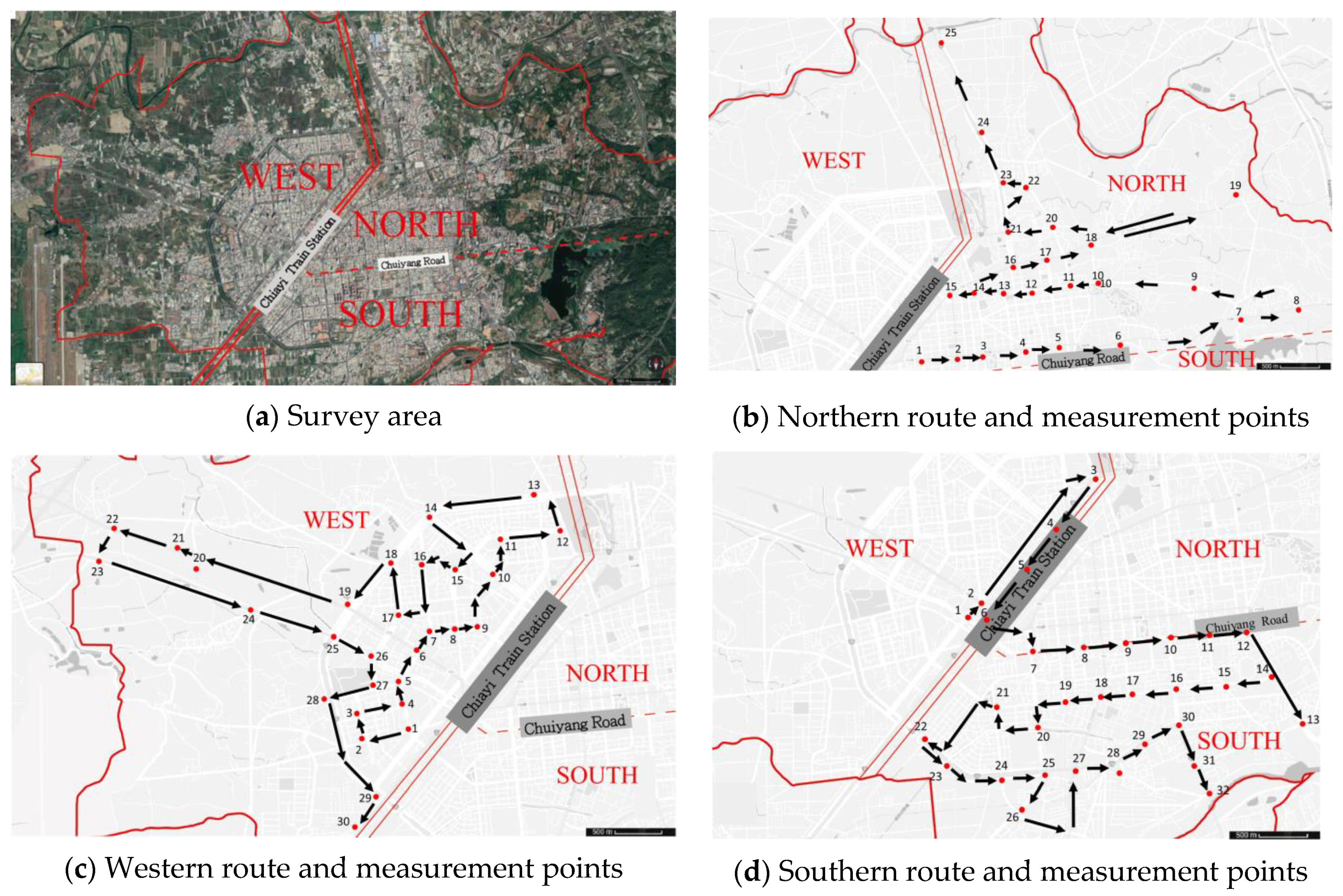
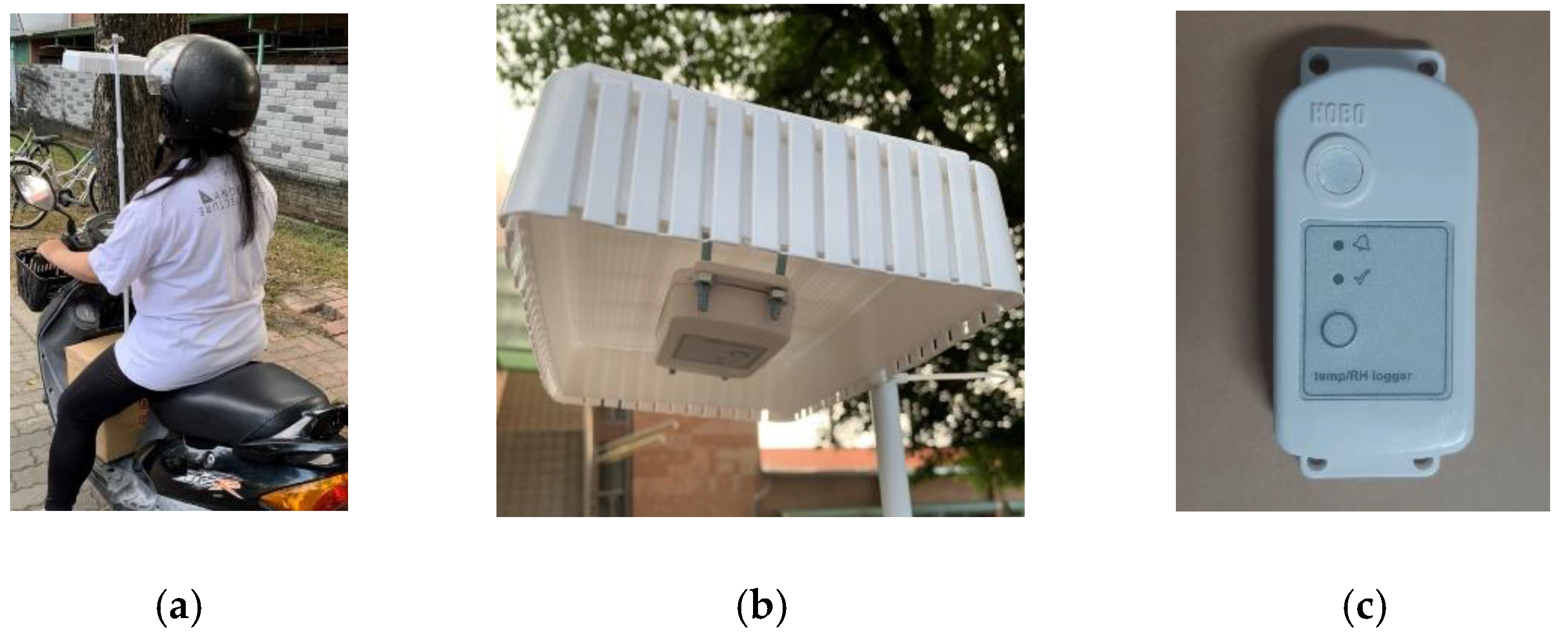
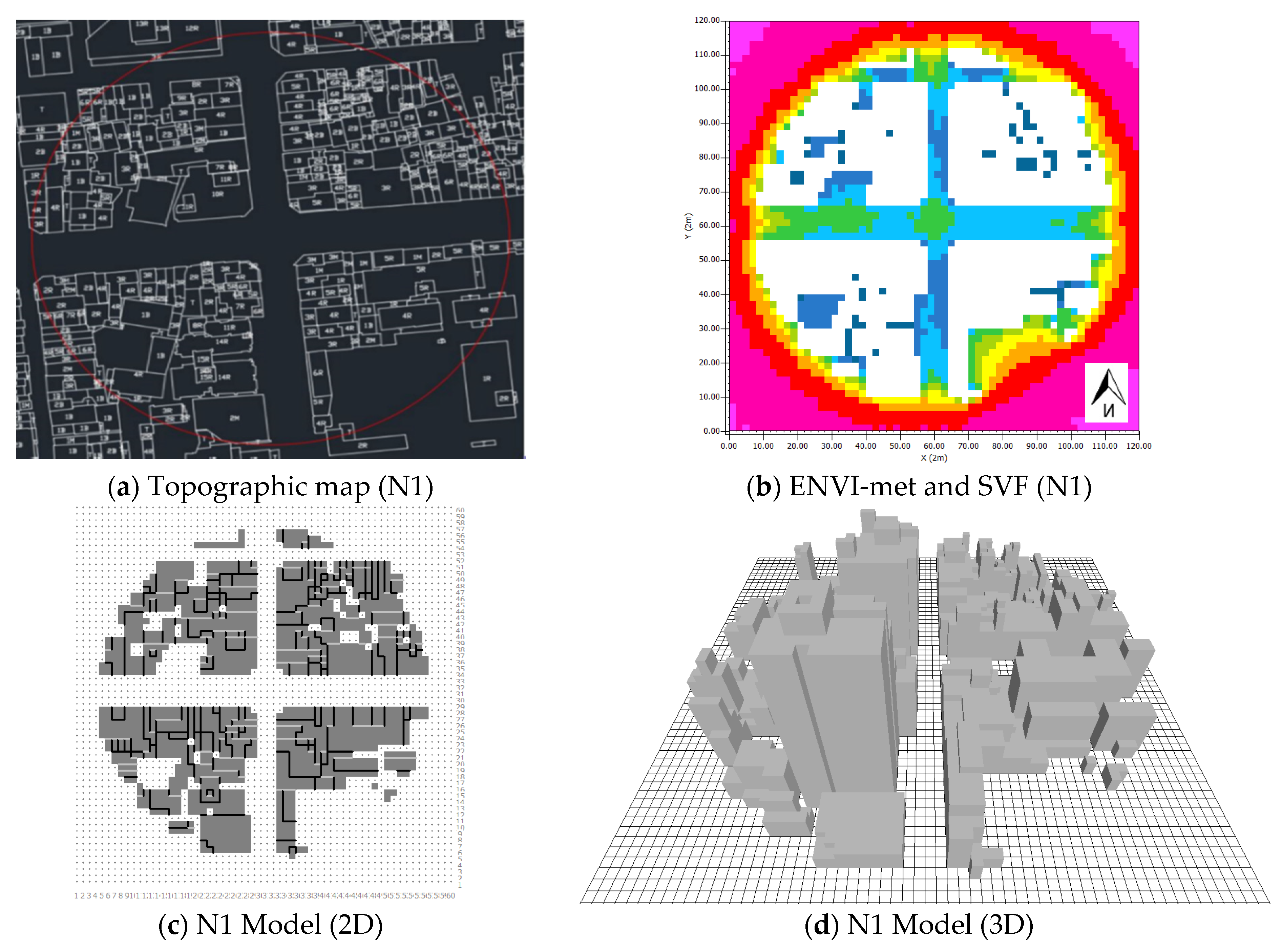


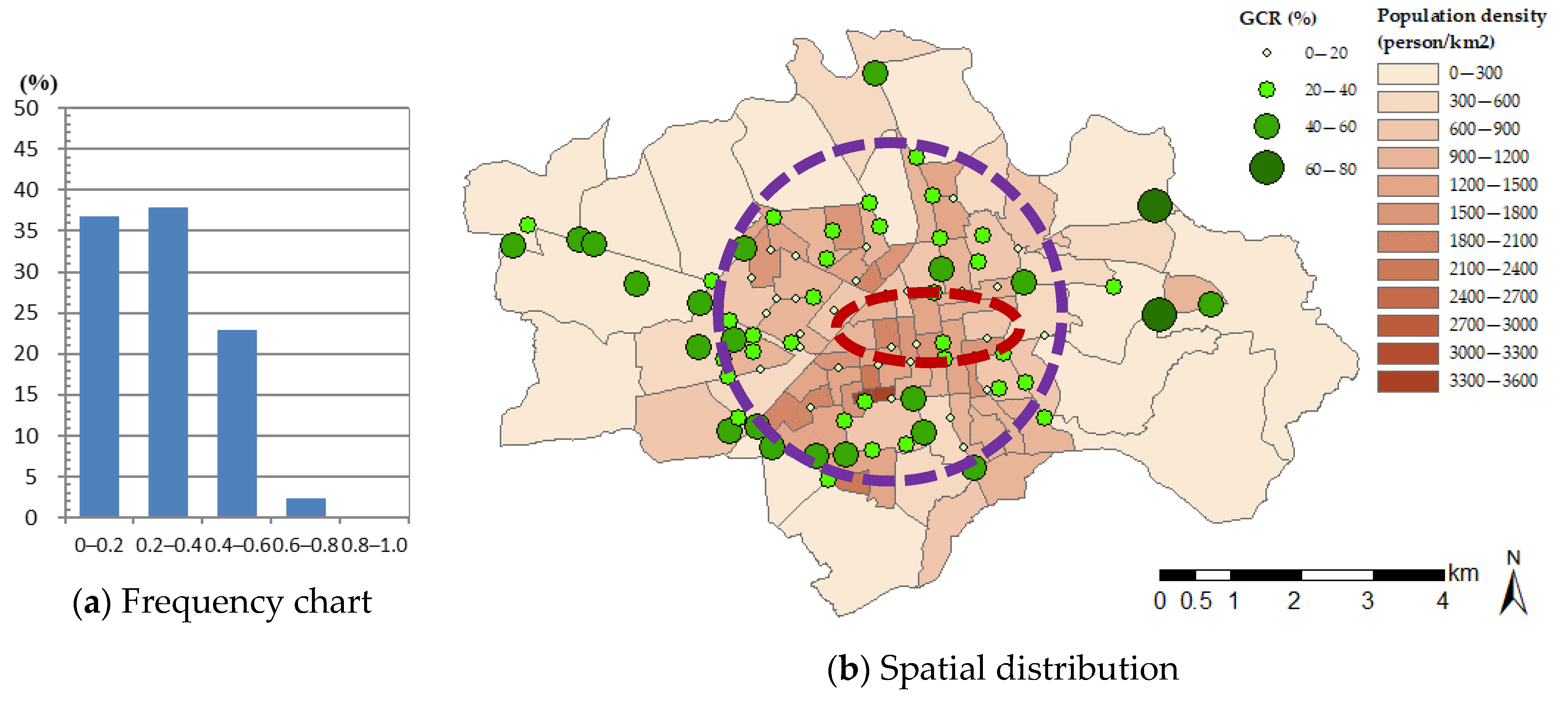
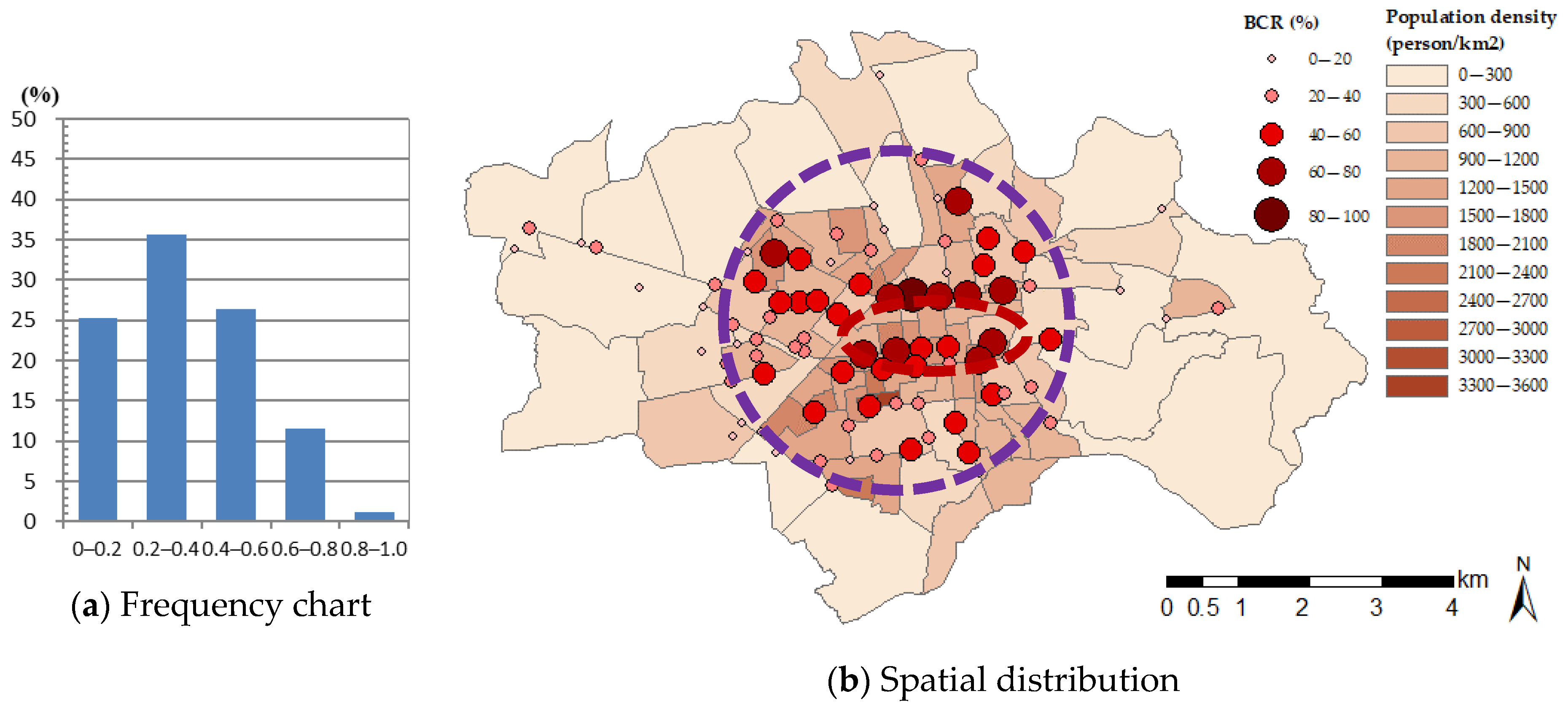
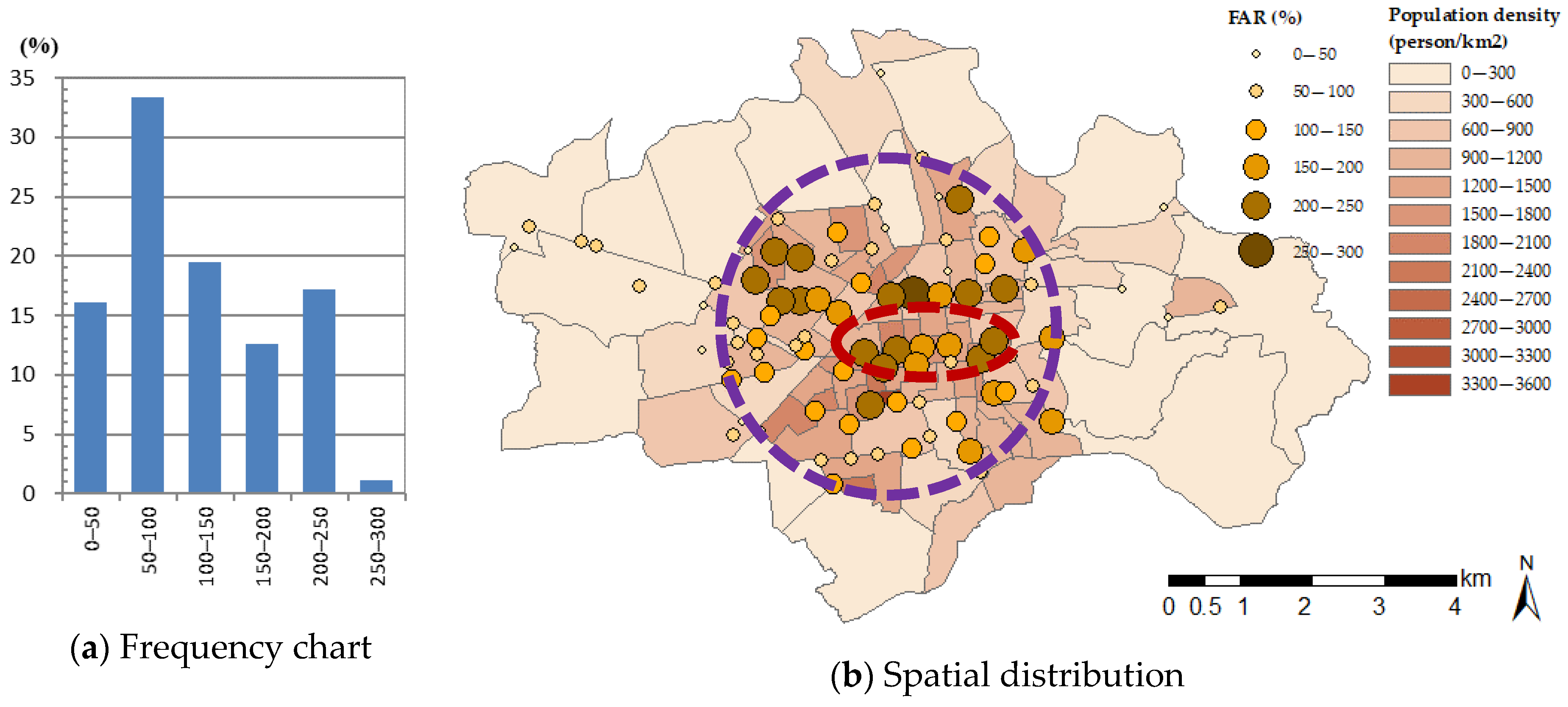
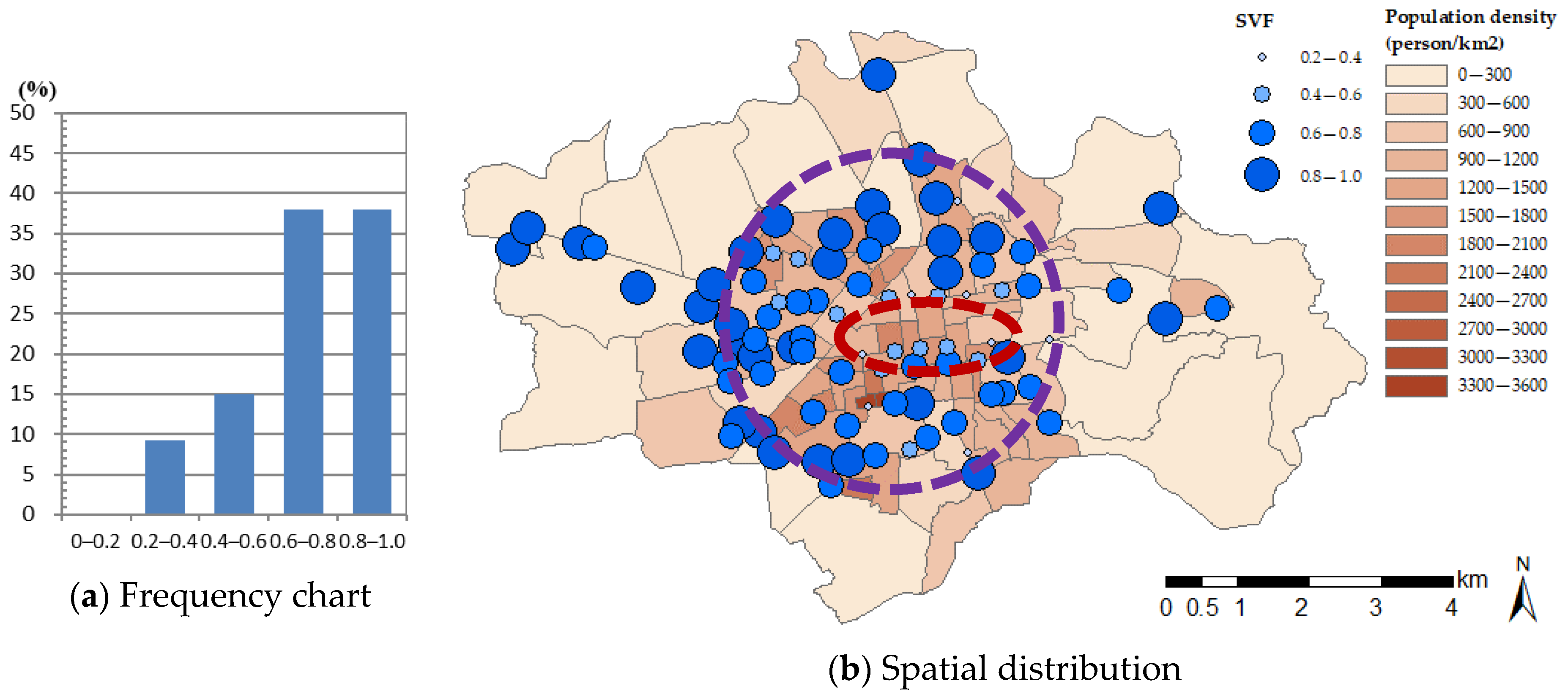
| Parameter | Daytime | Midnight | |||||||
|---|---|---|---|---|---|---|---|---|---|
| 28 July | 30 July 2018 | 31 July 2018 | |||||||
| 12 | 13 | 14 | 15 | 23 | 24 | 1 | 2 | 3 | |
| Temperature (°C) | 33.8 | 34.0 | 34.0 | 33.6 | 28.7 | 28.4 | 28.1 | 27.1 | 26.7 |
| Wind velocity (m/s) | 1.1 | 2.0 | 3.1 | 2.6 | 1.1 | 0.7 | 0.9 | 0.4 | 0.3 |
| Cloud cover (0~10) | 7 | 7 | 7 | 8 | -- | -- | -- | -- | -- |
| Radiation (MJ/m2) | 1.82 | 2.43 | 2.49 | 2.03 | 0.0 | 0.0 | 0.0 | 0.0 | 0.0 |
| Time | Daytime (28 July 2018) | Midnight (30–31 July 2018) | ||||
|---|---|---|---|---|---|---|
| 12:00 | 13:00 | 14:00 | 23:30 | 00:30 | 01:30 | |
| Tmax (°C) | 38 | 36.5 | 37.5 | 29.3 | 29.1 | 28.5 |
| Tmin (°C) | 35 | 33.5 | 33.6 | 27.6 | 27.7 | 26.0 |
| ΔTu-r (°C) | 3.0 | 3.0 | 3.9 | 1.7 | 1.4 | 2.5 |
| r | 12:00 | 13:00 | 14:00 | |
|---|---|---|---|---|
| All Zones | GCR | 0.07 | −0.37 | −0.38 |
| BCR | −0.13 | 0.43 | 0.27 | |
| FAR | −0.13 | 0.43 | 0.26 | |
| SVF | 0.11 | −0.40 | −0.28 | |
| Northern Zone (45%, BCR) | GCR | −0.33 | −0.22 | −0.27 |
| BCR | 0.26 | 0.37 | 0.32 | |
| FAR | 0.29 | 0.36 | 0.33 | |
| SVF | −0.08 | −0.49 | −0.37 | |
| Southern Zone (40%, BCR) | GCR | −0.26 | −0.39 | −0.59 |
| BCR | 0.32 | 0.26 | 0.38 | |
| FAR | 0.28 | 0.31 | 0.31 | |
| SVF | −0.23 | −0.15 | −0.35 | |
| Western Zone (30%, BCR) | GCR | 0.33 | −0.48 | −0.39 |
| BCR | −0.45 | 0.58 | 0.30 | |
| FAR | −0.45 | 0.55 | 0.28 | |
| SVF | 0.28 | −0.46 | −0.41 | |
| r | 23:30 | 00:30 | 01:30 | |
|---|---|---|---|---|
| All Zones | GCR | 0.11 | −0.40 | −0.27 |
| BCR | −0.18 | 0.22 | 0.03 | |
| FAR | −0.16 | 0.25 | 0.06 | |
| SVF | 0.30 | −0.10 | 0.12 | |
| Northern Zone (45%, BCR) | GCR | −0.02 | −0.21 | −0.10 |
| BCR | −0.11 | 0.01 | 0.02 | |
| FAR | −0.15 | 0.03 | −0.02 | |
| SVF | 0.29 | 0.01 | 0.14 | |
| Southern Zone (40%, BCR) | GCR | 0.25 | −0.60 | −0.44 |
| BCR | −0.22 | 0.30 | 0.12 | |
| FAR | −0.19 | 0.25 | 0.16 | |
| SVF | 0.24 | −0.19 | 0.03 | |
| Western Zone (30%, BCR) | GCR | −0.13 | −0.41 | −0.59 |
| BCR | 0.09 | 0.63 | 0.58 | |
| FAR | 0.06 | 0.65 | 0.53 | |
| SVF | −0.06 | −0.42 | −0.53 | |
| Chiayi City | Taipei [29] | |||||||
|---|---|---|---|---|---|---|---|---|
| Present Study | Previous Study [23,24] | |||||||
| Survey and Analysis Methods | Survey Method | Locomotive-Mobile Observations | Locomotive-Mobile Observations | Locomotive-Mobile Observations | ||||
| Survey Points | 87 | 208 | 750 | |||||
| Buffer Size | 100 m | 1000 m | 200 m | |||||
| Survey Time | 2018 | 1999 | 2012 | |||||
| Daytime (13:00) | Midnight (00:30) | Daytime (14:00) | Midnight (02:00) | Daytime (12:00–14:00) | Midnight (02:00–04:00) | |||
| r | 2D | GCR | −0.37 | −0.40 | −0.62 | −0.60 | −0.29 | −0.45 |
| BCR | 0.43 | 0.22 | - | - | 0.30 | 0.40 | ||
| Artificial Coverage Ratio (ACR) (= −GCR) | - | - | 0.63 | 0.52 | - | - | ||
| 3D | FAR | 0.42 | 0.29 | - | - | - | - | |
| SVF | −0.41 | −0.11 | - | - | - | - | ||
| Coefficients of Correlation (r) | Daytime | Midnight | ||||||
|---|---|---|---|---|---|---|---|---|
| 12:00 | 13:00 | 14:00 | 23:30 | 00:30 | 01:30 | |||
| R = 200 m | 2D | GCR | 0.16 | −0.37 | −0.31 | 0.02 | −0.44 | −0.29 |
| BCR | −0.17 | 0.39 | 0.24 | −0.11 | 0.26 | 0.07 | ||
| 3D | FAR | −0.30 | 0.51 | 0.15 | −0.22 | 0.17 | 0.06 | |
| SVF | 0.16 | −0.46 | −0.27 | 0.18 | −0.35 | 0.23 | ||
| R = 1000 m | 2D | GCR | 0.02 | −0.17 | −0.43 | −0.04 | −0.29 | −0.31 |
| BCR | −0.13 | 0.29 | 0.34 | 0.01 | 0.39 | 0.26 | ||
Publisher’s Note: MDPI stays neutral with regard to jurisdictional claims in published maps and institutional affiliations. |
© 2021 by the authors. Licensee MDPI, Basel, Switzerland. This article is an open access article distributed under the terms and conditions of the Creative Commons Attribution (CC BY) license (http://creativecommons.org/licenses/by/4.0/).
Share and Cite
Huang, J.-M.; Chang, H.-Y.; Chen, L.-C.; Wang, Y.-S. Canopy-scale Built-environment Characteristics and Urban Heat Island Effect in a Tropical Medium-sized City. Sustainability 2021, 13, 868. https://doi.org/10.3390/su13020868
Huang J-M, Chang H-Y, Chen L-C, Wang Y-S. Canopy-scale Built-environment Characteristics and Urban Heat Island Effect in a Tropical Medium-sized City. Sustainability. 2021; 13(2):868. https://doi.org/10.3390/su13020868
Chicago/Turabian StyleHuang, Jou-Man, Heui-Yung Chang, Liang-Chun Chen, and Yu-Su Wang. 2021. "Canopy-scale Built-environment Characteristics and Urban Heat Island Effect in a Tropical Medium-sized City" Sustainability 13, no. 2: 868. https://doi.org/10.3390/su13020868
APA StyleHuang, J.-M., Chang, H.-Y., Chen, L.-C., & Wang, Y.-S. (2021). Canopy-scale Built-environment Characteristics and Urban Heat Island Effect in a Tropical Medium-sized City. Sustainability, 13(2), 868. https://doi.org/10.3390/su13020868






